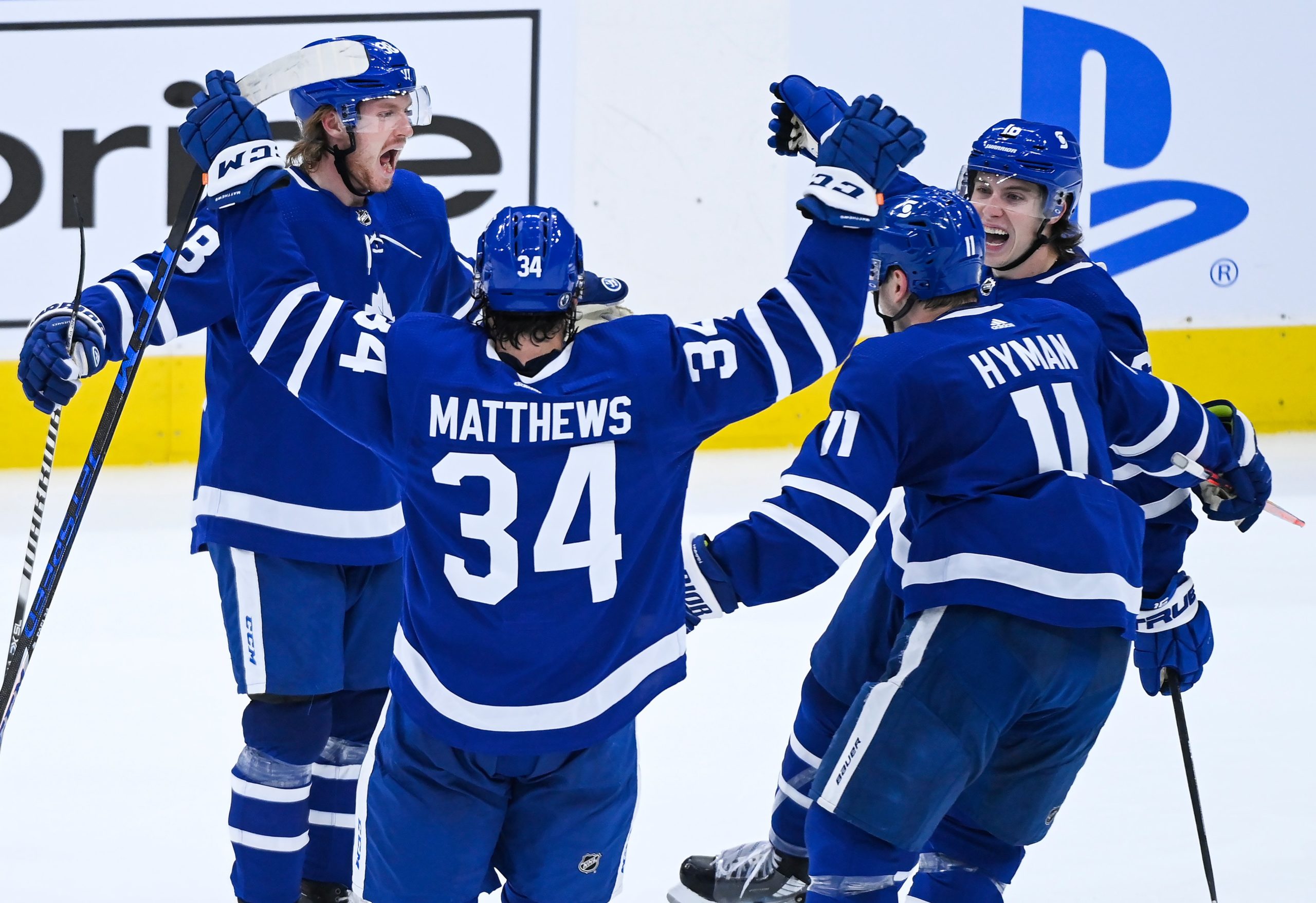After an emotionally charged Game 1, the Toronto Maple Leafs took care of business in a much-needed statement game of sorts to settle down the unease and get this series headed in the right direction.
It almost seems strange to remember that the Habs actually scored first in this game. After the 1-0 goal, there were a few nervous minutes, but the Leafs were able to tie it and settle in from there. Once they took the lead, it never really felt in doubt.
We said it before the series and again after Game 1: if the Leafs power play isn’t scoring and the top line is limited by the Philip Danault line, we have a series. Well, tonight was the opposite scenario.
The power play potted two, Auston Matthews scored at 5v5, and the third period was relatively stress free for Leafs fans.
Your game in 10:
1. There was a lot of talk about the Nick Foligno vs. Corey Perry fight during and after Game 1. Many eyebrows were raised when Wayne Simmonds started the first shift of the game — was he going to try to fight someone right away? He didn’t, but I don’t think that’s the story here. The Habs were notably going out of their way to be physical with the Leafs – a strategy we’ve seen against them for years now – and I think the Leafs were simply trying to push back a little.
After getting outhit 55-27 in the first game, the Leafs outhit the Habs 20-17 in the first period of this game. They shouldn’t be getting into a hitting battle, but there was a definite emphasis on generating pushback in this game, which, in part, likely precipitated Simmonds starting the first shift of the night.
2. The thing that stood out the most about the Leafs’ first goal of the game is that they simply continued firing pucks on net – from literally any angle – and kept winning battles to get it back and do it again until they scored. There were three shot attempts on that shift prior to the Jason Spezza goal. It’s a very, very simple game at times — you have to win those battles and you have to get pucks through.
Like Columbus, Montreal is concentrating on defending the house and there isn’t much in the way of getting clean looks in the slot or chances off the rush. At times, you have to simply throw pucks on net and win battles, allowing the game to open up from there.
The Habs’ first goal of the night was very similar as well. Leading up to the 1-0, the Leafs blocked one shot, Campbell saved one, and they got the favourable bounce off the skate to Armia before the puck was in the back of the net.
3. In a game against Calgary earlier this year, Justin Holl came down on the rush and put a perfect pass off the pad to Wayne Simmonds for an empty-net finish. Here he was again — this time in the playoffs — joining the rush and placing a perfect pass off of the pad to Auston Matthews for an empty-net goal.
I’ve mentioned this on our podcast and written about it a few times before, but shooting far pad at the proper height (roughly six inches off the ice) in the ankle area of the goalie is basically impossible for a netminder to control. They already know they are kicking the rebound out to the far-side player, and if the player is an opposing attacker, it’s more or less an automatic goal. That shot handcuffs a goalie.
4. After Game 1, I wrote about how the Rasmus Sandin – Zach Bogosian pairing struggled, along with the power play. Part of that note was to say if Sandin isn’t going to add to the power play, you might as well just play Travis Dermott knowing that the Dermott – Bogosian pairing is legitimately solid at 5v5. Tonight was a different story, underscored by Sandin scoring.
If he’s going to do that — and that means using his shot as a weapon, not necessarily scoring all the time — teams will have to respect it and it changes the whole dynamic of the power play. In particular, it creates more time and space for Matthews — they actually have to give pause when Sandin has the puck.
Bogosian also jumped in on the forecheck, which led to the Spezza goal. Later in the first period, he joined the rush and made a play to set up Ilya Mikheyev for a scoring opportunity. All in all, that pairing finished with seven shot attempts versus two against and was on for a goal for at 5v5. A big turnaround.
5. Heading into the trade deadline, I noted that Rasmus Sandin would be my only untouchable because I think he’s a legitimate top-four, cost-controlled defenseman on a team that is going to be perennially close to the cap. That is a great asset to have, and he has been steadily good in his NHL time already.
After an up-and-down Game 1 where he took some heat for the eventual game-winner, I can’t say enough good things about how he came back and played the way that he played in Game 2. It is tough in any playoff situation — and especially in this market — to come up with that kind of response. Kudos to him. It is promising for not just his future but this playoff run.
6. Inserting Pierre Engvall into the lineup made a noticeable difference — in particular, the speed of the third line made things happen. Riley Nash is a handy player who is useful in specific situations as a checking center, but Engvall brings speed and he can create some offense as well. In the second period, he just missed a goal on a snapshot (that Price barely got a piece of) on a rush that he started in the first place in the neutral zone.
This line also started the shooting gallery that led to the Spezza goal. If nothing else, all three can defend, bring speed, and they can forecheck. In the third, Engvall got in on the forecheck, created a turnover, and set up Alex Kerfoot for another scoring chance (which he shot wide). On their next shift, Engvall knocked down Weber on the forecheck, they got the puck back, and Weber proceeded to cross-check Engvall, giving the Leafs another power play. They scored on that power play to make it 4-1.
The third line was buzzing, in large part due to their speed, and they were tilting the ice the right way. Their on-ice shot attempts were 10-2. You can survive in the playoffs, for the most part, with a fourth line that doesn’t do much, but you absolutely do need three lines.
7. I have no reservations in stating that Montreal’s coach’s challenge on the 3-1 goal was one of the worst challenges I have ever seen, in any sport, ever. They couldn’t possibly overturn it, and while the Leafs didn’t make them pay again on the power play that resulted from the failed challenge, it ate up another two minutes of the game that the Leafs were already handily controlling.
In the second period, the Habs failed to record a high-danger scoring chance at 5v5. The Leafs created four at 5v5, plus four power plays. While they only scored on one of those power plays, they were dangerous on all of them. The importance there is that the Leafs have had some power plays over the past few months that have been so bad they’ve basically zapped the energy out of the team once 5v5 returns. With the way they were rolling, they continued that dominance through to their 5v5 play and then back to the power play before eventually scoring.
Auston Matthews was aggressively hunting his shot on the power play, which opens up all sorts of opportunities. While we’ve talked about the Sandin marker, it was notable that the other one came with William Nylander and Matthews on the ice together — one on each half-wall. While Nylander buried after Matthews hit the post, it was still a shooter putting home the goal.
8. I thought the returns on the Alex Galchenyuk – Nick Foligno – William Nylander line were mixed. Foligno was notably hanging back and playing a conservative brand of hockey, which makes sense considering he was centering two offensive-minded wingers. That said, the best assets that Foligno brings — forechecking, breaking out along the boards, battling in front of the net — are all neutered by this.
The line was out-attempted 14-10, playing primarily against the Nick Suzuki – Tyler Toffoli line (although, in fairness, it was pretty spread out). They were also caught running around and conceded the one goal against that the Leafs gave up.
The good news is the rest of the team played so well around them that it wasn’t a true liability, but it was a mixed result for this line. Maybe it needs a little time to gel together.
9. A tad more balanced ice-time distribution for the Leafs this game. Zach Hyman – Auston Matthews – Mitch Marner all played over 22 minutes, but none hit the 23-minute mark. After that, the next highest forward was William Nylander at 16:40. It’s tough when that second line isn’t exactly clicking, but Nylander has generally been good through two games (and not just the two goals), and he has yet to play a notable amount.
The next highest forward was actually Alex Kerfoot, in part because he plays on both special teams. The Leafs also had a bunch of power plays. While they aren’t exactly rolling four lines, they were able to get their top-line minutes down to a number that is much more palatable, and that’s important — especially in a series that is about to start a back-to-back (which is beyond ridiculous, by the way, but I digress).
The Habs forward with the most ice time was Phillip Danault with 19:29. No other Habs forward hit the 19-minute mark. Gallagher was under 13 minutes on the night (again, still playing hurt). It seems clear to me that the Leafs are trying to blitz them with their top guns because the Habs simply don’t have the gamebreakers of their own.
10. Morgan Rielly again led the defense in ice time and was active carrying the puck up the ice, but he was not alone tonight. Zach Bogosian was active, Justin Holl jumped up leading to a goal, TJ Brodie had his moments, and Rasmus Sandin was lugging it up. An opponent standing up on the blue line makes it hard for the forwards to skate with it through the neutral zone — the defenders are so tight to them, and they take all the way space. That is not the case for defensemen who are hanging back – they actually get a bit more time and space to wind up and can help break those neutral-zone formations.
The Leafs were sending forwards to the far blue line — especially after defensive-zone faceoff wins — and either getting it up to them to deflect it in and get after it, or using the space to have their mobile defenders skate it up the ice and make plays. It was a nice little counter to help open things up. Once they got rolling, they were able to create all sorts of chances.
11. Bonus note because I had to include it: Two playoff games, two very good starts for Jack Campbell. That is arguably the most promising thing that has happened here through two games. It is excellent news for the Leafs.






































